Site
1 Site layout, October 2004
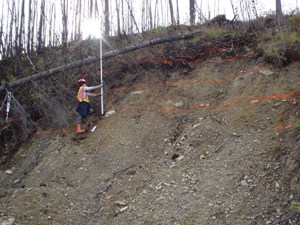
|
Site
1 installed brush layers and contour fascines
October 2004
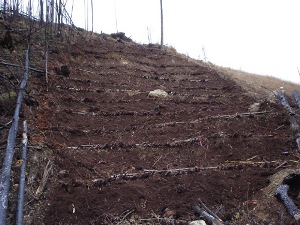
|
Site
1 showing one season of growth, October 2005
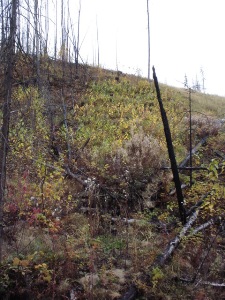
|
Site
1, June 2006
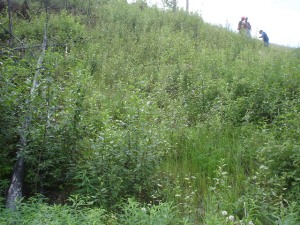
|
Site
1, June 2006
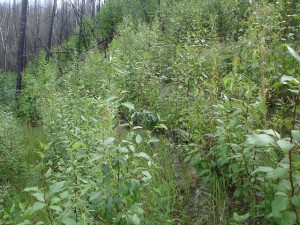
|
Site
2 before treatment, October 2004
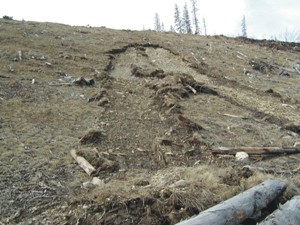
|
Site
2 installed brush layers and contour fascines
October 2004
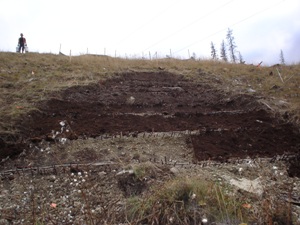
|
Site
2 and 3, October 2005
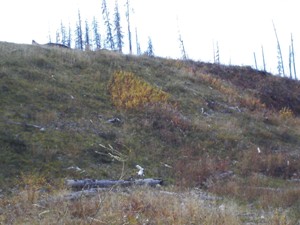
|
Site
2, June 2006
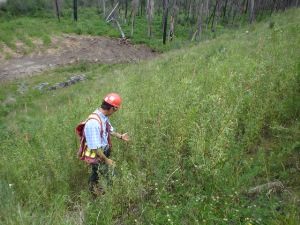
|
Installed
live pole drain system across right of way October
2004
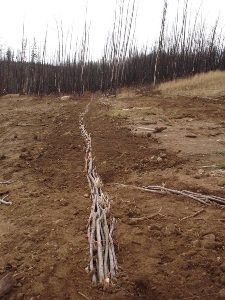
|
Growth
on live pole drain system, October 2005
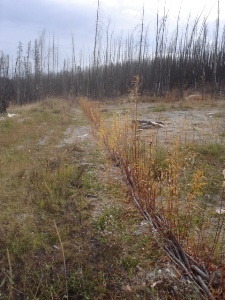
|
| Phase
II:
Location:
South
side of Beaver Creek adjacent to pipeline right-of-way.
Objective:
To stabilize a small slope failure using
a live pole drain system.
During
snowmelt in the spring of 2005 a small slope failure
occurred on a site adjacent to the Beaver Creek
crossing. This is thought to have resulted from
the concentration of redirected surface seepage
water from Phase I remedial work. In October 2005
a live pole drain (LPD) system was installed on
the slope failure in order to provide drainage
capacity for the seepage water on the slope. This
system consisted of a central live pole drain
with lateral drain fascines and brush layers.
The structures were constructed of the following
willow species; Salix bebbiana , Salix
scouleriana and Salix exigua , and Black
Cottonwood (Populus balsamifera L) cuttings.
Muskeg was applied to the site as mulch after
installation of these structures, and the area
was broadcast seeded with native grasses and inoculated
with endo mycorrhizae fungi. To date this treatment
has been successful at controlling soil erosion
and further mass wasting in this area. |
| |
Phase
II slope failure adjacent to Beaver Creek crossing,
October 2005
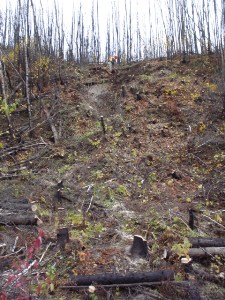
|
Phase
II installed live pole drain system
October
2005
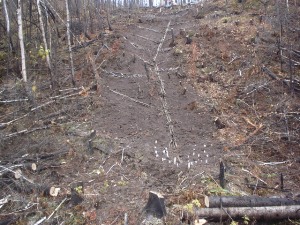
|
Phase
II, June 2006
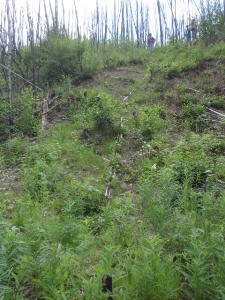
|
Phase
II, June 2007
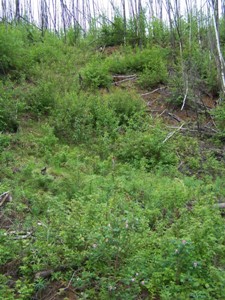
|
Phase
II, June 2007
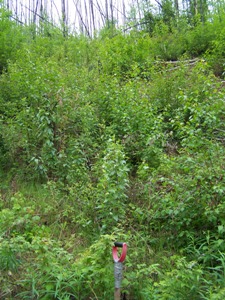
|
| Phase
III:
Location:
Both north and south sides of Beaver Creek within
pipeline right-of-way.
Objective:
Control surface erosion and seepage over
areas disturbed during repair of pipeline rupture
using soil bioengineering structures to establish
vegetation and enhance riparian habitat.
Extensive
areas, within Phase I, were disturbed as a result
of repair work to a pipeline rupture that occurred
in the spring of 2007. A narrow area was left
undisturbed on either side of the creek to act
as a buffer during the repair work. In the summer
of 2007 Syncrude graded and re-contoured the site,
according to TEC specifications. In order to re-vegetate
and stabilize this area, the following treatments
developed by TEC were installed in October 2007.
In the fall of 2007 TEC was retained to carry
out the field implementation, in association with
Terracon Geotechnique Ltd., who provided the contract
administration on behalf of Syncrude Canada Ltd.
-
South
side of creek: Brush layers and contour fascines
were installed on steeper slope areas. Damaged
portions of LPD structures installed on a
bench during Phase I were replaced. Muskeg
and broadcast seeding of native seed mix inoculated
with endo mycorrhizae fungi was applied. Planting
of native shrubs (Rosa acicularis) was carried
out over all disturbed areas. Structures were
constructed of the following willow species;
Salix bebbiana , Salix scouleriana
and Salix exigua. A temporary access
trail was constructed in order to transport
materials such as muskeg to the lower portion
of the site. The access trail was re-contoured
and re-vegetated after completion of the work.
-
North
side of creek: Brush layers and straw wattles
were installed on slope areas. Muskeg spreading
was done concurrently with brush layer planting
(piles placed on slope before hand). Broadcast
seeding of native seed mix inoculated with
endo mycorrhizae fungi and planting of native
shrubs (Rosa acicularis) was carried out over
all the disturbed areas. Structures were constructed
of the following willow species; Salix
bebbiana , Salix scouleriana and
Salix exigua, as well as a small proportion
of Black Cottonwood (Populus balsamifera
L) cuttings.
On
both the north and south sides, straw-bale sediment
barriers and silt fencing were installed between
the disturbed areas and the creek buffer zone
prior to treatments. Brush layer and LPD installation
was machine-assisted using a walking excavator
(Spyder Hoe). Contour fascines and straw wattles
were installed manually.
Communication
with Syncrude Canada Ltd informed us that the
site was growing and draining well during the
summer of 2008. The site will be monitored by
a Terra Erosion Control representative during
the spring of 2009.
Go To:
Monitoring Summer 2009
|
| |
Beaver
Creek Phase III, June 2007
(photo
Syncrude Canada Ltd)
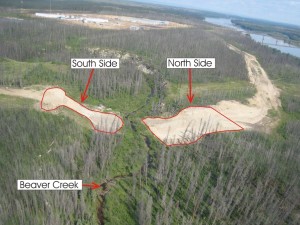
|
Graded
and re-contoured slope south side of Beaver
October 2007
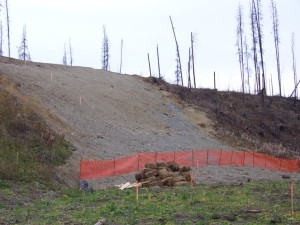
|
Foreground
– bench area top of slope south side; background
– graded slope on north side of
Beaver
Creek. Muskeg/mulch piles, October 2007
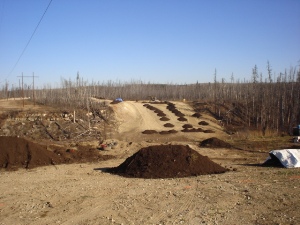
|
Machine-assisted
installation of brush layers
south
side, October 2007
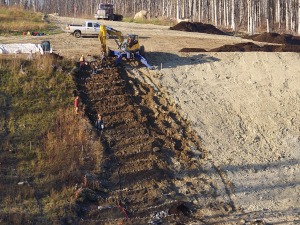
|
Work
in progress & material transport on
temporary
access trail
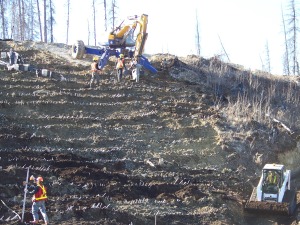
|
Installed
brush layers and contour fascines on
south
side, October 2007
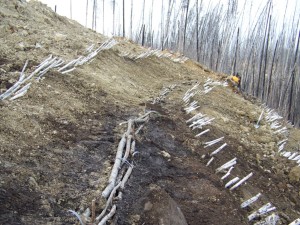
|
Installation
of Live Pole Drain system
on
south side, October 2007
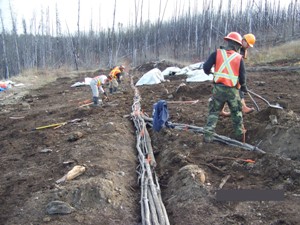
|
Completed
work on south side, October 2007
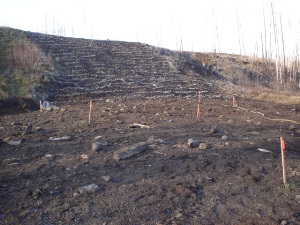
|
Completed
work on south side, October 2007
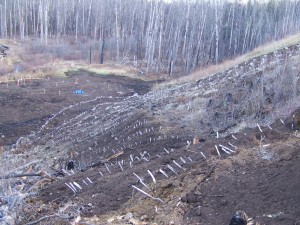
|
Re-contouring
and vegetating of temporary
access
trail, October 2007
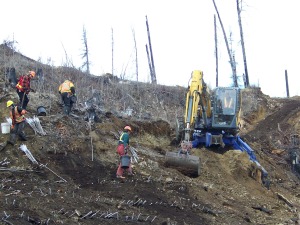
|
Re-contouring
and vegetating of temporary
access
trail, October 2007
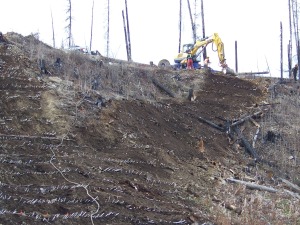
|
Machine-assisted
planting north side
October
2007
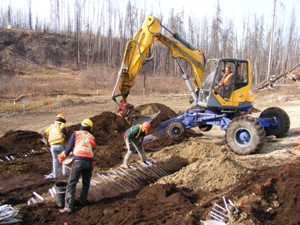
|
Machine-assisted
planting north side
October
2007
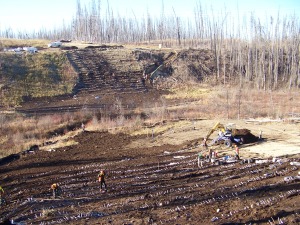
|
North
side partially completed
October
2007
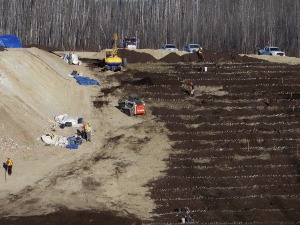
|
Straw
wattle installation north side
October
2007
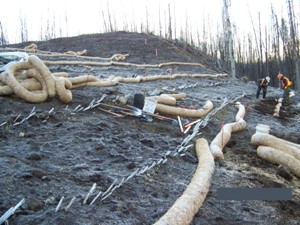
|
Straw
wattle installation north side
October
2007
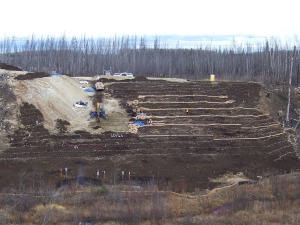
|
Completed
work north side October 2007
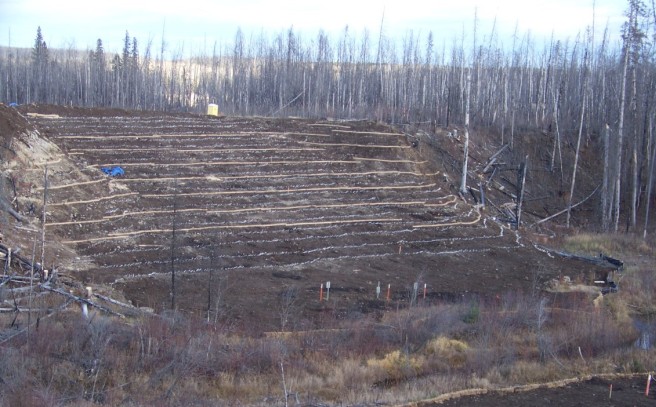
|
| |
Monitoring 2009:
The growth and establishment of native vegetation through soil bioengineering structures was considered excellent overall during the site visit of July 2009. There was no need for additional maintenance treatments on the north side at that time. On the south side, the live pole drains areas were disturbed in the summer of 2008 as a result of additional repair work carried out to the pipeline up slope. This repair work caused the concentration of water flowing over the re-habilitated area resulting in a small surface slope failure (see photo). |
| |
North side, July 2009

|
North side, July 2009
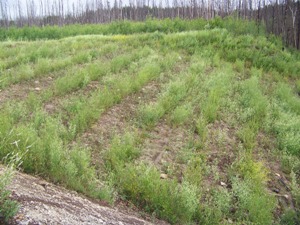
|
| |
North side, July 2009
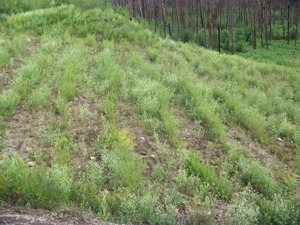
|
North side, July 2009

|
| |
North side, July 2009
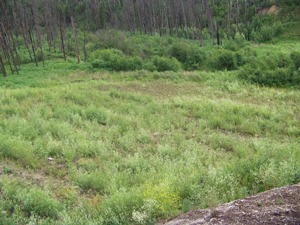
|
Brush layer growth and native grass establishment, July 2009
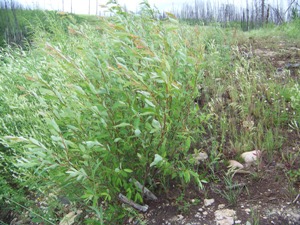
|
| |
Planted Rosa acicularis growth, July 2009
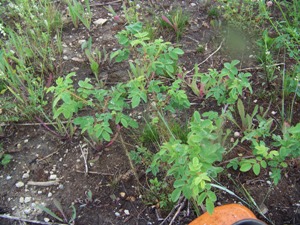
|
Field visit, July 2009
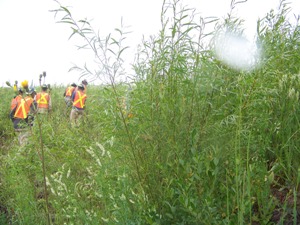
|
| |
South side, note small failure caused by pipeline repair up slope, July 2009
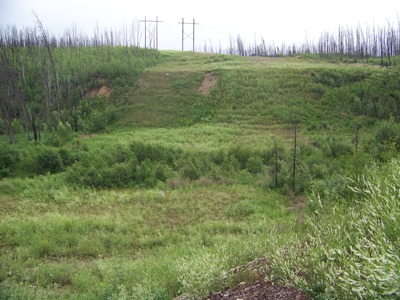
|
| |

Copyright © 2010
Terra Erosion Control Ltd.
Pipeline Right-of-Way Reclamation Project
|

